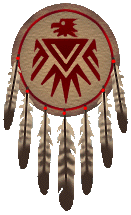You may then use these links continue through the letters or to get back to the index where you started. Back to Letter index
Letter 2
Letter 3
Letter 4
Letter 5

Omaha Weather Service forecaster Benny Gullach said the ritual immediately came to mind when he examined a photo of the United States that had been taken from a weather satellite.
Was it a coincidence? Or had someone Up There gotten the message?
In any case, Gullach was amazed to discover that the clouds above Nebraska had formed what for all the world appeared to be the head of an Indian Chief, complete with ceremonial headdress.
I have seen the picture; there seems to be an Indian Chief there, all right. A colleague went so far as to suggest that the chief “appears to be looking over toward Wounded Knee”.
“We felt our prayers were answered. Everything was happening just like in the book, “Black Elk Speaks”. Even the rain and hail came, like in the book.
|
 ”Sun” - P-20 (6-T), displays the ancient coloration of the African Barb that Plains Indian cultures felt held special significance. Al Fast Horse, a Brule Sioux and leader among the Sioux, held a Horse Dance on June 1976 to honor this true Medicine Horse, Sun, and to celebrate the resurgence of the Sioux Nation. Sioux elders see the discovery of Sun (by Al Fast Horse) as the most positive sign in the last several generations that the “circle” will be rejoined. The “Circle” is a metaphor for the Indian people’s spiritual well-being and wholeness in life and culture. Sun is owned by T.R. Hughes of Seward, Nebraska.
”Sun” - P-20 (6-T), displays the ancient coloration of the African Barb that Plains Indian cultures felt held special significance. Al Fast Horse, a Brule Sioux and leader among the Sioux, held a Horse Dance on June 1976 to honor this true Medicine Horse, Sun, and to celebrate the resurgence of the Sioux Nation. Sioux elders see the discovery of Sun (by Al Fast Horse) as the most positive sign in the last several generations that the “circle” will be rejoined. The “Circle” is a metaphor for the Indian people’s spiritual well-being and wholeness in life and culture. Sun is owned by T.R. Hughes of Seward, Nebraska.
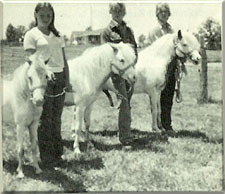 Three of Sample’s sons are presented here to compare the uncanny resemblance between these ponies and the African Barb horse “Sun”. These ponies and horses are distinguished by an unusual roan paint pattern, which is often very difficult to breed out. They are basically white horses with color concentrated on the ears and poll (the bonnet), color on the chest (shield), around the eye, a mark on each flank and one above the tail.
Three of Sample’s sons are presented here to compare the uncanny resemblance between these ponies and the African Barb horse “Sun”. These ponies and horses are distinguished by an unusual roan paint pattern, which is often very difficult to breed out. They are basically white horses with color concentrated on the ears and poll (the bonnet), color on the chest (shield), around the eye, a mark on each flank and one above the tail.
The Northern Cheyenne preferred paint horses, as did various other Plains tribes, however they had a special desire for the paints that wore the same battle dress as did the Cheyenne; the bonnet and the shield. The Indians regard for Medicine horses grew to the point of believing the horses were possessed of the supernatural.
When the Cheyenne discovered these horses to be prolific breeders of paints, many consistently marked with the bonnet and the “shields of protection”, they took this trait as a special “sign”.
The Indian believed quite strongly in the invincibility and courage of his Medicine Horse. Relying on the powers of this horse, the Indian readily used him as his buffalo-hunter, his war pony and ceremonial horse.
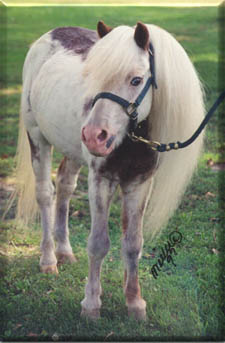 The unusual coat pattern of the Medicine Horse traces its origins directly to the African Barb. The Barb, at one time, carried several distinctive spotted types within the breed. There was an all white strain with small black spots scattered over the entire body, including the legs, known as the Lybian Spotted Barb. Another branch, exported to England in the early days, had a dark head and forequarters and a white rump spotted with small dark dots. At that time, they were called butterfly horses in England. There were the all white animals that carried dark ears and a dark cap on the poll. It was this unique marking that proved so difficult to breed out and which reappeared years after the Spanish horse was transferred to America.
The unusual coat pattern of the Medicine Horse traces its origins directly to the African Barb. The Barb, at one time, carried several distinctive spotted types within the breed. There was an all white strain with small black spots scattered over the entire body, including the legs, known as the Lybian Spotted Barb. Another branch, exported to England in the early days, had a dark head and forequarters and a white rump spotted with small dark dots. At that time, they were called butterfly horses in England. There were the all white animals that carried dark ears and a dark cap on the poll. It was this unique marking that proved so difficult to breed out and which reappeared years after the Spanish horse was transferred to America.
archived here by Carolyn Miller…... 2/21/01
*The above information was given to me by Lois Myler from Vance’s collection.
I am unable to give credit to the writer as the notes were very poor copies without acknowledgement of writer or publication. Presented here for public education.
Choose a page from the drop down menu and press go
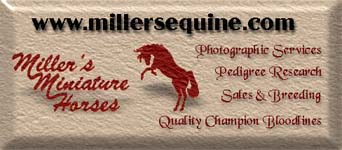
Photos and Content Copyright © 2001 Miller's Miniature Horses |
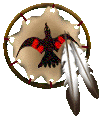 It was the day after the Sioux Indian presentation of the Horse Dance at Waterloo, Neb. Described as one of the most sacred Sioux rituals, the dance was regarded as a symbolic coming together of the Sioux Nation, whose “circle” was broken at Wounded Knee.
It was the day after the Sioux Indian presentation of the Horse Dance at Waterloo, Neb. Described as one of the most sacred Sioux rituals, the dance was regarded as a symbolic coming together of the Sioux Nation, whose “circle” was broken at Wounded Knee.